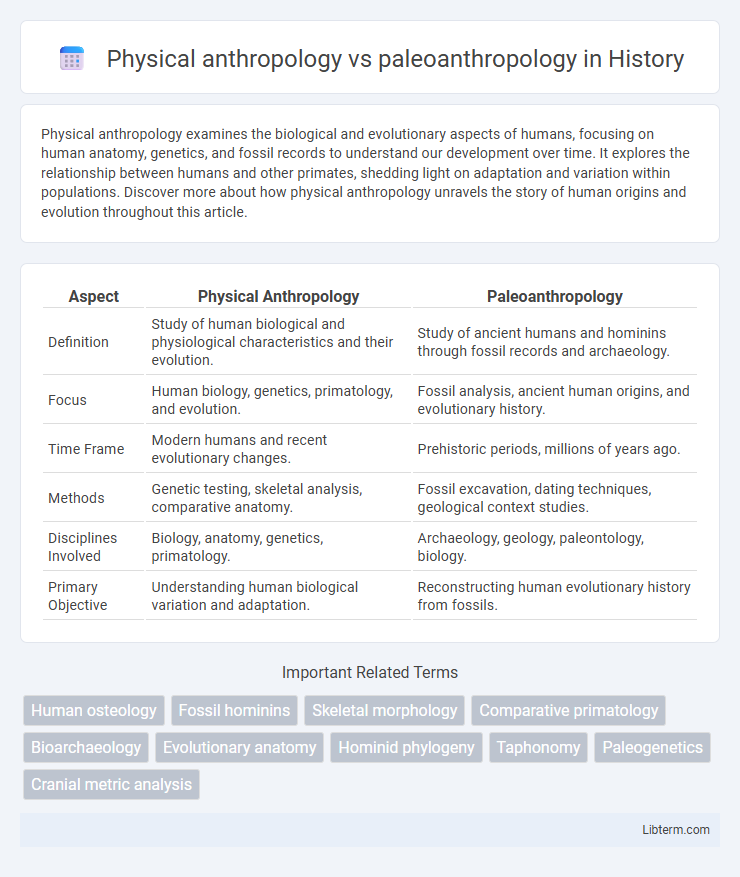Physical anthropology examines the biological and evolutionary aspects of humans, focusing on human anatomy, genetics, and fossil records to understand our development over time. It explores the relationship between humans and other primates, shedding light on adaptation and variation within populations. Discover more about how physical anthropology unravels the story of human origins and evolution throughout this article.
Table of Comparison
| Aspect | Physical Anthropology | Paleoanthropology |
|---|---|---|
| Definition | Study of human biological and physiological characteristics and their evolution. | Study of ancient humans and hominins through fossil records and archaeology. |
| Focus | Human biology, genetics, primatology, and evolution. | Fossil analysis, ancient human origins, and evolutionary history. |
| Time Frame | Modern humans and recent evolutionary changes. | Prehistoric periods, millions of years ago. |
| Methods | Genetic testing, skeletal analysis, comparative anatomy. | Fossil excavation, dating techniques, geological context studies. |
| Disciplines Involved | Biology, anatomy, genetics, primatology. | Archaeology, geology, paleontology, biology. |
| Primary Objective | Understanding human biological variation and adaptation. | Reconstructing human evolutionary history from fossils. |
Introduction to Physical Anthropology
Physical anthropology, a core subfield of anthropology, examines human biological and physiological characteristics and their evolution. It explores genetic inheritance, human adaptation, primatology, and forensic analysis to understand human variation and development. Paleoanthropology, a specialized branch, focuses on the fossil record and ancient human ancestors, providing critical insights into evolutionary history.
Defining Paleoanthropology
Paleoanthropology is a specialized branch of physical anthropology that studies the origins and evolution of ancient humans through fossil evidence and archaeological findings. Unlike broader physical anthropology, which examines contemporary human biology and variation, paleoanthropology focuses on reconstructing the biological and cultural development of early hominins over millions of years. Key paleoanthropological discoveries include Australopithecus afarensis fossils and Homo habilis remains, which provide critical insights into human evolutionary history.
Historical Development of Both Fields
Physical anthropology emerged in the 19th century, focusing on human biological diversity, evolution, and anatomy through study of living populations and skeletal remains. Paleoanthropology developed as a subfield of physical anthropology, concentrating on ancient human fossils and prehistoric life with key discoveries like the Neanderthal skull in the mid-1800s solidifying its foundation. Both fields evolved alongside advances in fossil dating techniques and genetics, enabling refined understanding of hominid evolution and human origins.
Key Methods in Physical Anthropology
Physical anthropology employs methods such as skeletal analysis, forensic anthropology, and comparative anatomy to study human biological variation and evolution. Techniques like osteology and bioarchaeology enable researchers to understand growth patterns, health, and ancestry through bone examination. Genetic analysis and primatology also provide critical insights into human adaptation and evolutionary relationships.
Major Approaches in Paleoanthropology
Major approaches in paleoanthropology emphasize fossil analysis, comparative anatomy, and archaeological context to reconstruct human evolutionary history. Techniques such as radiometric dating and morphological assessment help determine the age and characteristics of hominid fossils, while paleoenvironmental studies provide insights into the habitats and behaviors of early human ancestors. This multidisciplinary approach integrates genetics, geology, and primatology to understand phylogenetic relationships and adaptive strategies over millions of years.
Comparative Scope: Living vs. Fossil Populations
Physical anthropology primarily examines living human populations, analyzing anatomical variation, genetics, and behavior to understand human diversity and evolution in a contemporary context. Paleoanthropology focuses on fossil populations, studying ancient hominid remains and archaeological evidence to reconstruct evolutionary history and trace morphological changes over millions of years. Comparative analyses between living humans and fossil specimens provide critical insights into evolutionary processes, adaptation, and lineage divergence within the hominin clade.
Interdisciplinary Connections
Physical anthropology integrates biology, genetics, and anatomy to study human evolution and variation, while paleoanthropology combines archaeology, geology, and paleontology to examine fossil records of early hominins. Both fields collaborate closely with disciplines such as molecular biology for DNA analysis, and environmental science to understand ancient habitats. This interdisciplinary approach enhances understanding of human origins, adaptation, and evolutionary processes by combining diverse scientific methods and perspectives.
Notable Discoveries and Milestones
Physical anthropology has revealed significant insights into human variation and adaptation through studies such as the discovery of the "Turkana Boy" skeleton, illuminating early Homo erectus anatomy. Paleoanthropology made groundbreaking milestones with the unearthing of Australopithecus afarensis fossils like "Lucy" in Ethiopia, providing crucial evidence of bipedalism dating back 3.2 million years. Both fields contribute to understanding human evolution but paleoanthropology primarily focuses on ancient hominin fossils, while physical anthropology encompasses broader aspects of human biological diversity and evolution.
Current Challenges and Debates
Physical anthropology faces challenges in integrating advanced genetic data with traditional morphological analyses, complicating interpretations of human variation. Paleoanthropology debates center on fossil record gaps and dating accuracy, hindering understanding of hominin evolutionary pathways. Both fields grapple with ethical issues regarding indigenous remains and the impact of new technologies on reconstructing human ancestry.
Future Directions in Human Evolutionary Studies
Physical anthropology is expanding its focus on genetic and morphological data integration to better understand human biological diversity, while paleoanthropology emphasizes advanced fossil analysis and sedimentary DNA techniques to uncover ancient hominin behavior. Future directions in human evolutionary studies involve leveraging machine learning algorithms and 3D imaging to reconstruct evolutionary patterns and environmental adaptations with unprecedented precision. These interdisciplinary approaches aim to resolve controversies regarding hominin phylogeny and adaptive strategies in response to climatic shifts.
Physical anthropology Infographic

 libterm.com
libterm.com